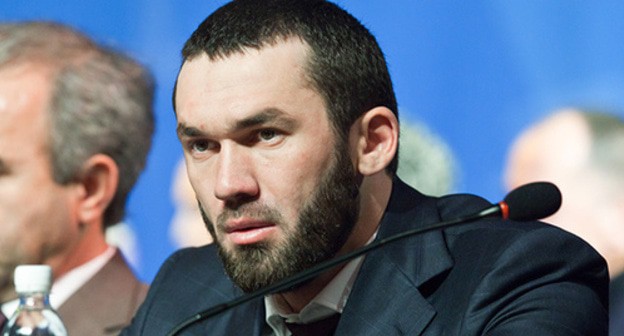Khushtada ziyarat
Khushtada ziyarat (Avar. Khushdadasa shaikhazabazul ziyarat), "holy" grave of three Naqshbandi sheikhs of the XIX-XX cent., well-known in Northwestern Dagestan. It is located in the Kh'armala graveyard in the Bagvalal settlement of Khushtada situated in the mountains on the right bank of the Andi-Koisu River, 12 km from the center of the Agvali settlement, Tsumada district.
The Khushtada ziyarat is a rectangular mausoleum (hujra) without a cupola, typical for XIX-XX centuries` Mountainous Dagestan. Its western wall has a small projection. The building is 5.7x6.2 m in size and 2 m high. It is made of roughly cut gray and brown stones. Three small pyramids of river gravel are built on the roof over the western wall. Two Arabic inscriptions are set into the outer wall of the crypt under them, each 28x44 cm in size. Like in other Dagestan ziyarats, high wooden poles with white and green ribbons are fixed near the hujra. The "holy" place and the XIX-XX centuries gravestones that surround it are enclosed in a low wall of roughly cut stones of irregular shape.
The epitaphs of the Khushtada ziyarat are curious evidence of the cult of "holy" martyrs among the Muslims in Soviet Dagestan. The earlier of them was cut on the 4th of Rabi-us-saani, 1354 (July 06, 1934), in memory of "the famous sheikh, perfect mentor and teacher (al-murshid al-kamil wal-ustaz) of the Naqshbandi order (Naqshbandiyya), sufferer Husayn, son of the known sheikh haji Pir Muhammad al-Hushdadi? who died as a martyr (shahid) in confinement? in 1349 (1930-31)." This raised inscription is already half-erased, as it was cut on soft sandstone. On the left of it is an epitaph in black ink composed in the manner of kalam (Islamic speculative theology) on a solid slightly yellowed industrially-made paper. It is composed on the occasion of death on the 1st of Zilhaj (Dhu'l-Hijjah), 1360 (December 20, 1941) of qadi 'Abdullah, son of Husayn and his successor as sheikh of the Naqshbandiyya. The epitaph says he "died hiding? from infidels and hypocrites (al-kuffar wa al-munafiqin) that murder scholars and saints (al-ulama wa-l-awliya) and loot their property." The second epitaph mostly repeats the genealogical and biographical data about Pir Muhammad and Husayn al-Hushdadi quoted in the first inscription.
It is known from Dagestan manuscripts and Khushtada legends the mausoleum was built shortly before the 1917 revolution over the grave of Husayn's father, Naqshbandi sheikh Pir Muhammad, son of Hajiyav, son of Pir Muhammad al-Hushdadi (1830/31-1911/12). He descended from a noble kindred (tukhum) of sayyids (leaders or chiefs), Shamkhal-g'ai, that traced themselves back to the Quraysh (also: Kuraish or Koreish - trans.) Arabs who had come to Dagestan together with legendary Abu Muslim. Sayyid tukhums of the same name (Shamkhal) are widespread in Highland Dagestan, in particular in Khushtada's neighboring Bagvalal settlement of Tlondoda and Chamalal settlements on the right bank of the Andi-Koisu. The private manuscript collections of M. Salmanov in Khushtada and Pir Muhammad's descendant S.-G. Pirmagomedov in Agvali have preserved alternative Shamkhal-g'ai genealogies recorded in the late XIX through early XX cent. By that time, the tukhum numbered 12-14 generations of ulama (religious scholars) beginning with Ihakku, one of the first Muslim preachers in Khushtada (approximately the early XVI cent.). More than ten imams (dibirs) in Khushtada and other Dagestan settlements stemmed from this tukhum in the XVII-XIX cent.
Pir Muhammad ibn Hajiyav was appointed sheikh by his murshid Sa'id from the Avar settlement of Oboda. He, too, had a lot of students afterwards. Among them was Khuseniyav, sheikh and scholar of encyclopedic knowledge from the settlement of Gigatli, well-known in pre-revolutionary Dagestan, whose mausoleum (ziyarat) is situated at the entrance to Agvali. Pir Muhammad had a reputation of eminent scholar and Sufi mystic and took an active part in public works (the building inscriptions tell about his participation in restoring cathedral mosques in Khushtada and Botlikh in the late XIX cent.).
Born in 1861/62, Husayn was just the same renowned among Dagestan's ulama. He inherited the title of sheikh from his father. He was considered an authority in Sufism and Shafi'i fiqh (religious law). His rival was Shafi'-hajji (Shapi-gadji), son of Muhammad al-Hushdadi and Qadiri sheikh, who wrote a book on tariqah/tariqat (a Sufi order or brotherhood/lodge, usually headed by a teacher or master known as murshid or sheikh - trans.) that was popular with Dagestan's pre-revolutionary Sufis. Having ousted Shafi'-hajji from Khushtada with the help of his murids (disciples, students - trans.), Husayn became the settlement's qadi and chairman of the Sharia court set up there in the 1920s. In 1921-25, he maintained secret contacts with Dagestan's fifth imam Najm ad-Din from the settlement of Gotsob (Najmuddin Gotsinsky) who was hiding in neighboring Chechnya's mountains after the failed rebellion against the Soviet government. Husayn was arrested in 1930 and soon shot in the prison of the People's Commissariat of Internal Affairs (NKVD) in Makhachkala. Most books from the sheikh's huge library were burnt at the same time. Husayn's murids stole his body, transported it secretly to the mountains and buried in Khushtada.
Husayn's son, 'Abdullah, was arrested with his father and deported from Dagestan for five years. He was able to escape from his exile and get back to his native settlement. Husayn's supporters were hiding him in the mountains until he died and treated him as a spiritual leader and qadi of the community. His descendants were imams of the Khushtada community until recently. Now they head the Muslim communities in Agvali and some migrant settlements in the valley.
Residents of Khushtada and other nearby highland settlements revere Pir Muhammad's son Husayn more than other "saints." His figure had already been surrounded by multiple legends by the 1950s. He was attributed the ability to work miracles (karamat/karama): moving to remote places in a moment; going through walls; divining the future; turning tobacco, playing cards, and other things prohibited by the Sharia into worms; and so on. Husayn's supernatural abilities were extended to the Khushtada ziyarat. The natives have an idea that its "holiness" protects both the living and the dead, so wealthier residents of Khushtada tried to buy from the Muslim community the right to be buried in the Kh'armala graveyard to the 1970s. Sick people and infertile women came to the hujra for healing. Sick cattle were brought to Kh'armala to take them round the ziyarat a few times, in accordance with the widespread belief. Up to now, the village dibir arranges praying for rain near the "holy" place. On the most important Muslim holidays (Mawlid al-Nabi, Uraza-bairam (Turkic) / Eid al Fitr (Arabic) and Kurban-bayram (Turkic) / Eid al-Adha (Arabic)), adult men of Khushtada gather near the ziyarat, distribute meat and other sacrificial food (sadaka, sadaqa). The hujra looks well-groomed; it is often whitewashed and renovated.




![Tumso Abdurakhmanov. Screenshot from video posted by Abu-Saddam Shishani [LIVE] http://www.youtube.com/watch?v=mIR3s7AB0Uw Tumso Abdurakhmanov. Screenshot from video posted by Abu-Saddam Shishani [LIVE] http://www.youtube.com/watch?v=mIR3s7AB0Uw](/system/uploads/article_image/image/0001/18460/main_image_Tumso.jpg)